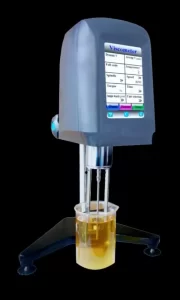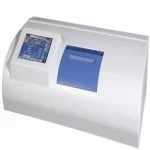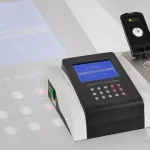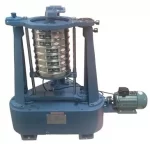VISCOMETER
VISCOMETER/VISCOSITY METER

The viscometer/viscosity meter is an instrument used to measure the viscosity of a given liquid. It is useful equipment in several laboratories and serves mainly to assist in the quality control of raw materials or certain products produced for industrialization. However, before talking more about the viscometer and its applications, it is necessary to define what a fluid’s viscosity is.
WHAT IS A LIQUID’S VISCOSITY AND HOW IS IT MEASURED?
Viscosity is related to the resistance of a liquid and refers to its ability to move when it is poured. In this context, viscosity is linked to a property of the liquid.
As an example, we can use water and oil. While water has less resistance and higher speed during dumping, oil is more resistant and has a lower speed when poured. Therefore, water is less viscous than oil.
FLUID BEHAVIORS:
The sheer force of a fluid occurs due to the forces of cohesion of the liquid with the walls of the container in which it is contained and between the fluid layers themselves. According to Newton, viscosity is calculated through the sheer force on the area to which the fluid is subjected and the speed gradient.
The behavior of fluids, at different shear rates, can be classified into two categories:
- NEWTONIAN FLUIDS
This type of fluid has a constant viscosity, regardless of the applied sheer speed. As an example of these liquids, we can highlight water and simple hydrocarbons.
- NON-NEWTONIAN FLUIDS
Non-Newtonians have their viscosity altered according to changes in sheer speed. In this context, fruit pulps, starch suspensions, and ketchup, for example, can be included.
According to the purpose of the measurement and the type of fluid, a suitable viscometer must be used. Follow the reading and understand the types of viscometer/viscosity meter and their purposes.
TYPES OF VISCOMETER/VISCOSITY METER:
Find out now what types of viscometer/viscosity meter exist:
- CAPILLARY VISCOMETER
This instrument measures the viscosity through the flow rate of the liquid, using a glass capillary. It is not suitable for non-Newtonian fluids as it does not allow shear stress to varying. It is widely used to measure Newtonian fluids with low viscosity.
- ORIFICE VISCOMETER
With an orifice viscometer/viscosity meter (ford cup), it is possible to measure viscosity by measuring the time it takes for a quantity of fluid to flow through a hole in the bottom of a given container. The measurement is made quickly and simplified and is widely used in paint and lubricating oil factories.
- ROTATIONAL VISCOMETER
It is the most suitable for measuring the viscosity of non-Newtonian fluids. In this way, viscosity is measured by the angular velocity of a moving part separated from a fixed part by the liquid.
VISCOSITY CONTROL IN THE PROCESS:
Viscosity is a physical property that determines the resistance that a fluid has to flow. This resistance is the product caused by its molecular friction. Whenever a fluid is moved or physically distributed, for example; when it is spread or mixed, shear occurs, which is the force necessary to move the fluid layers. The greater the friction, the greater the force required to cause the movement; thus, materials with high viscosity require greater strength to move than those with low viscosity.
Newtonian fluids are gases and simple liquids, including liquid metals, which obey Newton’s law of viscosity. On the other hand, polymeric solutions, pastes, and paints are classified as non-Newtonian, as they have non-linear behaviors, that is, the applied shear stress does not depend on the resulting deformation speed.
MORE INFO ABOUT VISCOMETER/VISCOSITY METER
Viscometers/viscosity meters are essential equipment in several types of laboratories. To ensure the purchase of equipment suitable for its purpose, it is necessary to analyze what type of fluid will be measured and what the purpose of the measurement is. In this way, it is possible to purchase a device that is useful and efficient for the work environment.
Viscometer/viscosity meter models have a coaxial cylindrical rotational sensor. In the in-line viscosity meter with a vibrating sensor, the measurement of viscosity is made from a vibrating sensor that generates a digital signal proportional to the viscosity. The product to be analyzed enters the measurement chamber where it is exposed to the measurement sensor. By submerging the sensor in the product to be analyzed, the vibrating rod detects the damping of the frequency emitted through the phase angle lag and converts it to viscosity values.
Technical Specification
| Model | VISCO 39 |
| RPM | 0.3, 0.6, 1.5, 3, 6, 12, 30 & 60 |
| No. of Standard Spindles | 4 Spindles |
| Measurement Accuracy | +/- 1% of Range |
| Repeatability | +/- 0.5% |
| Temperature RTD Monitoring Sensor Prope | Yes |
| Display | Touch Screen |
| Output | RS 232 Interface |
| Power Supply | 220V, 50 Hz |
| Dimension LxWxH (mm) | 400 x 350 x 360 |
| Weight | 9Kg |
Yatherm Scientific is a leading distributor/provider firm of viscometer/viscosity meter for several years, being a reference in companies, laboratories, and research centers in pen India and around the world. These viscometer instruments are intended for continuous control of the process viscosity within a given region of operation.
TO LEARN MORE ABOUT VISCOMETER/VISCOSITY METER:
Yatherm Scientific offers viscometer/viscosity meter with reliability, efficiency, and durability at an unbeatable price. We have a technical and scientific team to better assist the buyer and user, providing security and agility in the budgeting and purchasing process. You can call and contact us to learn more about viscometer/viscosity meter




